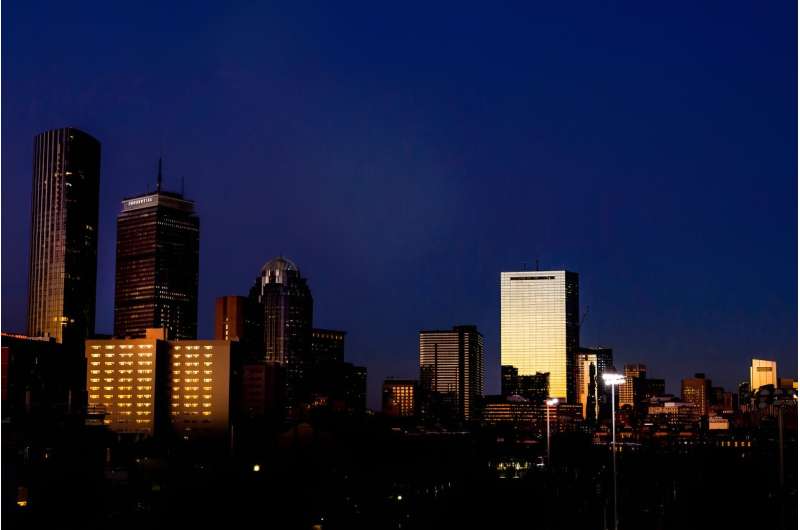This article has been reviewed according to Science X's editorial process and policies. Editors have highlighted the following attributes while ensuring the content's credibility:
fact-checked
trusted source
proofread
Why office-to-housing conversions are more complicated than they sound

Converting office space to housing units sounds like a win–win in the post-pandemic world of remote work and scarce housing.
But revitalizing business districts, eliminating a glut of vacant office space and creating much-needed housing by converting office space to apartments or condos is more complicated than it may sound, says Northeastern University associate professor Tim Love.
"For office buildings pre-World War II … they work well for conversions because the wings of the buildings are much narrower than modern office buildings. This was necessary because office workers needed to rely on natural light and ventilation before the advent of cheap electricity and air conditioning," says Love, an associate professor in the School of Architecture. Love is also the founding principal of Utile, an architecture and planning firm in Boston.
"Post-1970s office buildings," Love continues, "are much more difficult to convert."
Office vacancies continue to surge as the post-pandemic world of remote working changes American work culture, and higher interest rates and a slowing economy pause companies' expansion plans.
Housing, meanwhile, is scarce with both rental and homeowner housing vacancies near 20-year lows, and sales and rental prices continuing to climb. The problem is even more acute in major metropolitan regions such as Boston, New York City and the Bay Area.
Unsurprisingly, these metropolitan areas are also at the forefront of the offices-to-housing push.
New York City has a plan to convert offices to 20,000 units of housing, San Francisco has similar ambitions for converting offices, and Boston hopes to spark conversions by offering building owners a three-year tax abatement.
But Love notes it's easier said than done.
In fact, Love's firm recently completed a study of the viability of office-to-residential conversions in downtown Boston.
Utile found that there are 380 buildings in downtown Boston with primarily commercial use, of which 201 were potentially eligible for conversion.
However, since most developers won't tackle a small project, Love eliminated any buildings with a typical floor area of less than 7,500 square feet.
The potential conversion list drops to 55.
Why so few?
Love explains that many of the structures that were eliminated were modern commercial buildings that typically have several things that make conversion difficult.
First, office buildings built after 1970 have a much bigger and much greater square-foot floor plan than older buildings. This is because ventilation comes from central climate control systems as opposed to naturally through open windows and cross breezes (try opening a window on a skyscraper, and you'll likely get a visit from security).
Furthermore, cheap electricity enables much deeper and larger floor plans, because natural light is no longer a requirement for every room.
"The floorplans of pre-war buildings were designed more like Victorian radiators in profile when you needed natural light and natural ventilation, especially in the summer," Love says. "So they had relatively thin floor plans, operable windows, cross breezes, etc. and offices 25 to 27 feet deep. That is perfect for an apartment or condo."
Love notes that the "most efficient solution" for a developer to convert office space to residential units is to end up with a central corridor with apartments feeding off it in both directions—a so-called double-loaded corridor building.
"The ideal dimension for the width of such a building is 65 feet deep," Love says.
That being said, not all pre-war buildings are viable for conversion. Those that share a solid firewall with their neighbor (called a party wall) are difficult to convert because, at least in Boston, building code requires all bedrooms to have a window, Love notes.
And that doesn't mean it's impossible to convert a glass office tower to apartments. It's just that it gets more complex. For instance, how do you convert a centralized heating and air conditioning system into a system that can be individually metered for every apartment?
Or what would it cost to replace a glass building's windows—basically its entire exterior envelope—with ones that can be opened and shut? And what about that deep floorplan? What do you do with the space beyond 25 feet deep?
"Even converting pre-war buildings with ideal floor plans from office to residential uses is complicated and costly from a regulatory and technical perspective," says Love. "As a result, cities need to provide financial incentives to encourage the real estate market to act."
Still, Love says he thinks it's important for cities to enact aggressive policies soon in order to breathe new life into post-COVID downtowns. He says this will not only mitigate the housing crisis in Greater Boston but also convince more workers to spend more time in their downtown offices.
In other words, it's a win–win.
This story is republished courtesy of Northeastern Global News news.northeastern.edu.




















